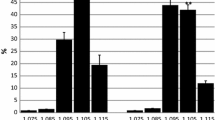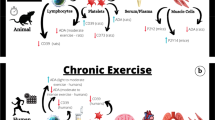Abstract
Nucleotidases participate in the regulation of physiological and pathological events, such as inflammation and coagulation. Exercise promotes distinct adaptations, and can influence purinergic signaling. In the present study, we investigated soluble nucleotidase activities in the blood serum of sedentary young male adults at pre- and post-acute moderate aerobic exercise. In addition, we evaluated how this kind of exercise could influence adenine nucleotide concentrations in the blood serum. Sedentary individuals were submitted to moderate aerobic exercise on a treadmill; blood samples were collected pre- and post-exercise, and serum was separated for analysis. Results showed increases in ATP, ADP, and AMP hydrolysis post-exercise, compared to pre-exercise values. The ecto-nucleotide pyrophosphatase/phosphodiesterase was also evaluated, showing an increased activity post-exercise, compared to pre-exercise. Purine levels were analyzed by HPLC in the blood serum, pre- and post-exercise. Decreased levels of ATP and ADP were found post-exercise, in contrast with pre-exercise values. Conversely, post-exercise levels of adenosine and inosine increased compared to pre-exercise levels. Our results indicate an influence of acute exercise on ATP metabolism, modifying enzymatic behavior to promote a protective biological environment.


Similar content being viewed by others
References
Bruneau ML, Johnson BT, Huedo-Medina TB, Larson KA, Garret IA, Pescatello LS (2015) The blood pressure response to acute and chronic aerobic exercise: a meta-analysis of candidate gene association studies. J Sci Med Sport. doi:10.1016/j.jsams.2015.05.009
Dempsey PC, Owen N, Biddle SJH, Dunstan DW (2014) Managing sedentary behavior to reduce the risk of diabetes and cardiovascular disease. Curr Diab Rep 14:522. doi:10.1007/s11892-014-0522-0
Rosenberg DE, Bellettiere J, Gardiner PA, Villarreal VN, Crist K, Kerr J (2015) Independent associations between sedentary behaviors and mental, cognitive, physical, and functional health among older adults in retirement communities. J Gerontolog A Biol Med Sci 71:78–83. doi:10.1093/gerona/glv103
Martin A, Fitzsimons R, Jepson R et al (2015) Interventions with potential to reduce sedentary time in adults: systematic review and meta-analysis. Br J Sports Med 49:1056–1063. doi:10.1136/bjsports-2014-094524
World Health Organization (2010) Global recommendations on physical activity for health. World Health Organization, Geneva. doi:10.1080/11026480410034349
Burnstock G (2009) Purinergic signalling: past, present and future. Braz J Med Biol Res 42:3–8. doi:10.1590/S0100-879X2008005000037
Eckle T, Krahn T, Grenz D et al (2007) Cardioprotection by ecto-5′-nucleotidase (CD73) and A2B adenosine receptors. Circulation 115:1581–1590. doi:10.1161/CIRCULATIONAHA.106.669697
Di Virgilio F, Ferrari D, Adinolfi E (2009) P2X7: a growth-promoting receptor—Implications for cancer. Purinergi Signal 5:251–256. doi:10.1007/s11302-009-9145-3
Rücker B, Abreu-Vieira G, Bischoff LB, Hartmann AD, Sarkis JJF, Wink MR, Casali EA (2010) The nucleotide hydrolysis is altered in blood serum of streptozotocin-induced diabetic rats. Arch Physiol Biochem 116:79–87. doi:10.3109/13813451003777067
Ralevic V, Burnstock G (1998) Receptors for purines and pyrimidines. Pharmacol Rev 50:413–492. doi:10.1007/978-3-642-28863-0_5
Yegutkin GG (2008) Nucleotide and nucleoside-converting ectoenzymes: important modulators of purinergic signalling cascade. Biochim Biophys Acta 1783:673–679. doi:10.1016/j.bbamcr.2008.01.024
Roque FR, Soci UPR, De Angelis K et al (2011) Moderate exercise training promotes adaptations in coronary blood flow and adenosine production in normotensive rats. Clinics 66:2105–2111. doi:10.1590/S1807-59322011001200017
Siqueira IR, Elsner VR, Rilho LS et al (2010) A neuroprotective exercise protocol reduces the adenine nucleotide hydrolysis in hippocampal synaptosomes and serum of rats. Brain Res 1316:173–180. doi:10.1016/j.brainres.2009.11.076
Cardoso AM, Bagatini MD, Martins CC et al (2012) Exercise training prevents ecto-nucleotidases alterations in platelets of hypertensive rats. Mol Cell Biochem 371:147–156. doi:10.1007/s11010-012-1431-7
Moritz CEJ, Abreu-Vieira G, Piroli C et al (2012) Physical training normalizes nucleotide hydrolysis and biochemical parameters in blood serum from streptozotocin-diabetic rats. Arch Physiol Biochem 118:253–259. doi:10.3109/13813455.2012.697173
Coppola A, Coppola L, dalla Mora L et al (2005) Vigorous exercise acutely changes platelet and B-lymphocyte CD39 expression. J Appl Physiol 98:1414–1419. doi:10.1152/japplphysiol.00315.2004
Yegutkin GG, Samburski SS, Mortensen SP, Jalkanen S, González-Alonso J (2007) Intravascular ADP and soluble nucleotidases contribute to acute prothrombotic state during vigorous exercise in humans. J Physiol 579:553–564. doi:10.1113/jphysiol.2006.119453
Shepard RJ (1988) PAR-Q, Canadian home fitness test and exercise screening alternatives. Sports Med 5:185–195. doi:10.2165/00007256-198805030-00005
Schneider CD, Barb J, Ribeiro JL, Belló-Klein A, Oliveira AR (2005) Oxidative stress after three different intensities of running. Can J Appl Physiol 30:723–734. doi:10.1139/h05-151
Lucía A, Hoyos J, Pérez M, Chicharro JL (2000) Heart rate and performance parameters in elite cyclists: a longitudinal study. Med Sci Sports Exerc 32:1777–1782
Bradford MM (1976) A rapid and sensitive method for the quantitation of microgram quantities of protein utilizing the principle of protein-dye binding. Anal Biochem 72:248–254. doi:10.1016/0003-2697(76)90527-3
Chan KM, Delfert D, Junger KD (1986) A direct colorimetric assay for Ca2+-stimulated ATPase activity. Anal Biochem 157:375–380. doi:10.1016/0003-2697(86)90640-8
Sakura H, Nagashima S, Nakashima A, Maeda M (1998) Characterization of fetal serum 5′-nucleotide phosphodiesterase: a novel function as a platelet aggregation inhibitor in fetal circulation. Thromb Res 91:83–89. doi:10.1016/S0049-3848(98)00073-5
Voelter W, Zech K, Arnold P, Ludwig G (1980) Determination of selected pyrimidines, purines and their metabolites in serum and urine by reversed-phase ion-pair chromatography. J Chromatogr 199:345–354. doi:10.1016/S0021-9673(01)91386-X
Brocklebank LA, Falconer CL, Page AS, Perry R, Cooper AR (2015) Accelerometer-measured sedentary time and cardiometabolic biomarkers: a systematic review. Prev Med 76:92–102. doi:10.1016/j.ypmed.2015.04.013
Manson JE, Skerret PJ, Greenland P, VanItallie TB (2004) The escalating pandemics of obesity and sedentary lifestyle. Arch Intern Med 164:249–258. doi:10.1001/archinte.164.3.249
Lin CH, Chiang SL, Tzeng WC, Chiang LC (2014) Systematic review of impact of lifestyle-modification programs on metabolic risks and patient-reported outcomes in adults with metabolic syndrome. Worldviews Evid Based Nurs 11:361–368. doi:10.1111/wvn.12069
Heinonen I, Kalliokoski KK, Hannukainen JC, Dunker DJ, Nuttila P, Knuuti J (2014) Organ-specific physiological responses to acute physical exercise and long-term training in humans. Physiology 29:421–436. doi:10.1152/physiol.00067.2013
Lippi G, Maffuli N (2009) Biological influence of physical exercise on hemostasis. Semin Thromb Hemost 35:269–276. doi:10.1055/s-0029-1222605
Mathur N, Pedersen BK (2008) Exercise as a mean to control low-grade systemic inflammation. Mediators Inflamm 2008:1–6. doi:10.1155/2008/109502
Cardoso AM, Abadalla FH, Bagatini MD et al (2015) Swimming training prevents alterations in ecto-NTPDase and adenosine deaminase activities in lymphocytes from Nω-nitro-l-arginine methyl ester hydrochloride induced hypertension rats. J Hypertens 33:763–772. doi:10.1097/HJH.0000000000000468
Lunkes GI, Lunkes DS, Leal D et al (2008) Effect of high glucose levels in human platelet NTPDase and 5′-nucleotidase activities. Diabetes Res Clin Pract 81:351–357. doi:10.1016/j.diabres.2008.06.001
Lunkes GI, Lunkes D, Stefanello F, Morsch A, Morsch VM, Mazzanti CM, Schetinger MRC (2003) Enzymes that hydrolyze adenine nucleotides in diabetes and associated pathologies. Thromb Res 109:184–194. doi:10.1016/S0049-3848(03)00178-6
Papanikolaou A, Papafotika A, Murphy C et al (2005) Cholesterol-dependent lipid assemblies regulate the activity of the ecto-nucleotidase CD39. J Biol Chem 280:26406–26414. doi:10.1074/jbc.M413927200
Duarte MMF, Loro VL, Rocha JBT et al (2007) Enzymes that hydrolyze adenine nucleotides of patients with hypercholesterolemia and inflammatory processes. FEBS J 274:2707–2714. doi:10.1111/j.1742-4658.2007.05805.x
Koch AJ, Pereira R, Machado M (2014) The creatine kinase response to resistance exercise. J Musculoskel Neuronal Interact 14:68–77
Moflehi D, Kok LY, Tengku-Fadilah TK, Amri S (2012) Effect of single-session aerobic exercise with varying intensities on lipid peroxidation and muscle-damage markers in sedentary males. Glob J Health Sci 23:48–54. doi:10.5539/gjhs.v4n4p48
Pedersen BK, Hoffman-Goetz L (2000) Exercise and the immune system: regulation, integration, and adaptation. Physiol Rev 80:1055–1081
Di Virgilio F, Vuerich M (2015) Purinergic signaling in the immune system. Auton Neurosci 191:117–123. doi:10.1016/j.autneu.2015.04.011
Mooren FC, Lechtermann A, Fobker M, Brandt B, Sorg K, Vöelker K, Nacken W (2006) The response of the novel pro-inflammatory molecules S100A8/A9 to exercise. Int J Sports Med 27:751–758. doi:10.1055/s-2005-872909
Thrall G, Lip GYH (2004) Exercise and the prothrombotic state: a paradox of cardiovascular prevention or an enhanced prothrombotic state? Arterioscler Thromb Vasc Biol 25:265–266. doi:10.1161/01.ATV.0000154579.11213.da
Birk AV, Broekman MJ, Gladek EM, Robertson HD, Drosopoulos JHF, Marcus AJ, Szeto HH (2002) Role of extracellular ATP metabolism in regulation of platelet reactivity. J Lab Clin Med 140:166–175. doi:10.1067/mlc.2002.126719
Jiang ZG, Wu Y, Csizmadia E et al (2014) Characterization of circulating microparticle-associated CD39 family ecto-nucleotidases in human plasma. Purinergic Signal 10:611–618. doi:10.1007/s11302-014-9423-6
Burnstock G (2015) Blood cells: an historical account of the roles of purinergic signalling. Purinergic Signal 11:411–434. doi:10.1007/s11302-015-9462-7
Haskó G, Sitkovsky MV, Szabó C (2004) Immunomodulatory and neuroprotective effects of inosine. Trends Pharmacol Sci 25:152–157. doi:10.1016/j.tips.2004.01.006
Hsiao G, Lin KH, Chang Y, Chen TL, Tzu NH, Chou DS, Sheu JR (2005) Protective mechanisms of inosine in platelet activation and cerebral ischemic damage. Arterioscler Thromb Vasc Biol 25:1998–2004. doi:10.1161/01.ATV.0000174798.25085.d6
Waring WS, McKnight JA, Webb DJ, Maxwell SRJ (2006) Uric acid restores endothelial function in patients with type 1 diabetes and regular smokers. Diabetes 55:3127–3132. doi:10.2337/db06-0283
Waring WS, Convery A, Mishra V, Shenkin A, Webb DJ, Maxwell SRJ (2003) Uric acid reduces exercise-induced oxidative stress in healthy adults. Clin Sci 105:425–430. doi:10.1042/CS20030149
Acknowledgements
This work was supported by Conselho Nacional de Desenvolvimento Científico e Tecnológico (CNPq) and Coordenação de Aperfeiçoamento de Pessoal de Nível Superior (CAPES). C.E.J Moritz and L. Rockenbach were recipients of CAPES fellowship.
Author information
Authors and Affiliations
Corresponding author
Ethics declarations
Conflict of interest
The authors declare that they have no conflict of interest.
Rights and permissions
About this article
Cite this article
Moritz, C.E.J., Teixeira, B.C., Rockenbach, L. et al. Altered extracellular ATP, ADP, and AMP hydrolysis in blood serum of sedentary individuals after an acute, aerobic, moderate exercise session. Mol Cell Biochem 426, 55–63 (2017). https://doi.org/10.1007/s11010-016-2880-1
Received:
Accepted:
Published:
Issue Date:
DOI: https://doi.org/10.1007/s11010-016-2880-1




